Late yesterday afternoon we did a modest 75-minute hike. Huffing and puffing up Kirkwood (35 degree uphill incline), and then a hard right on Appian Way. Pretty much the highest point in the hills. Clean air, blue sky, nice feeling.
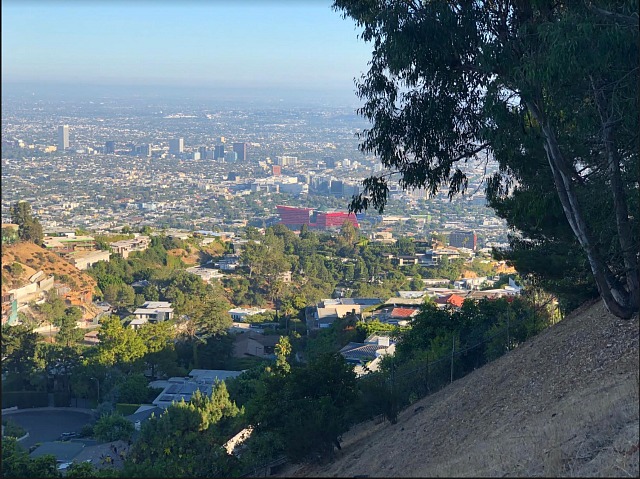

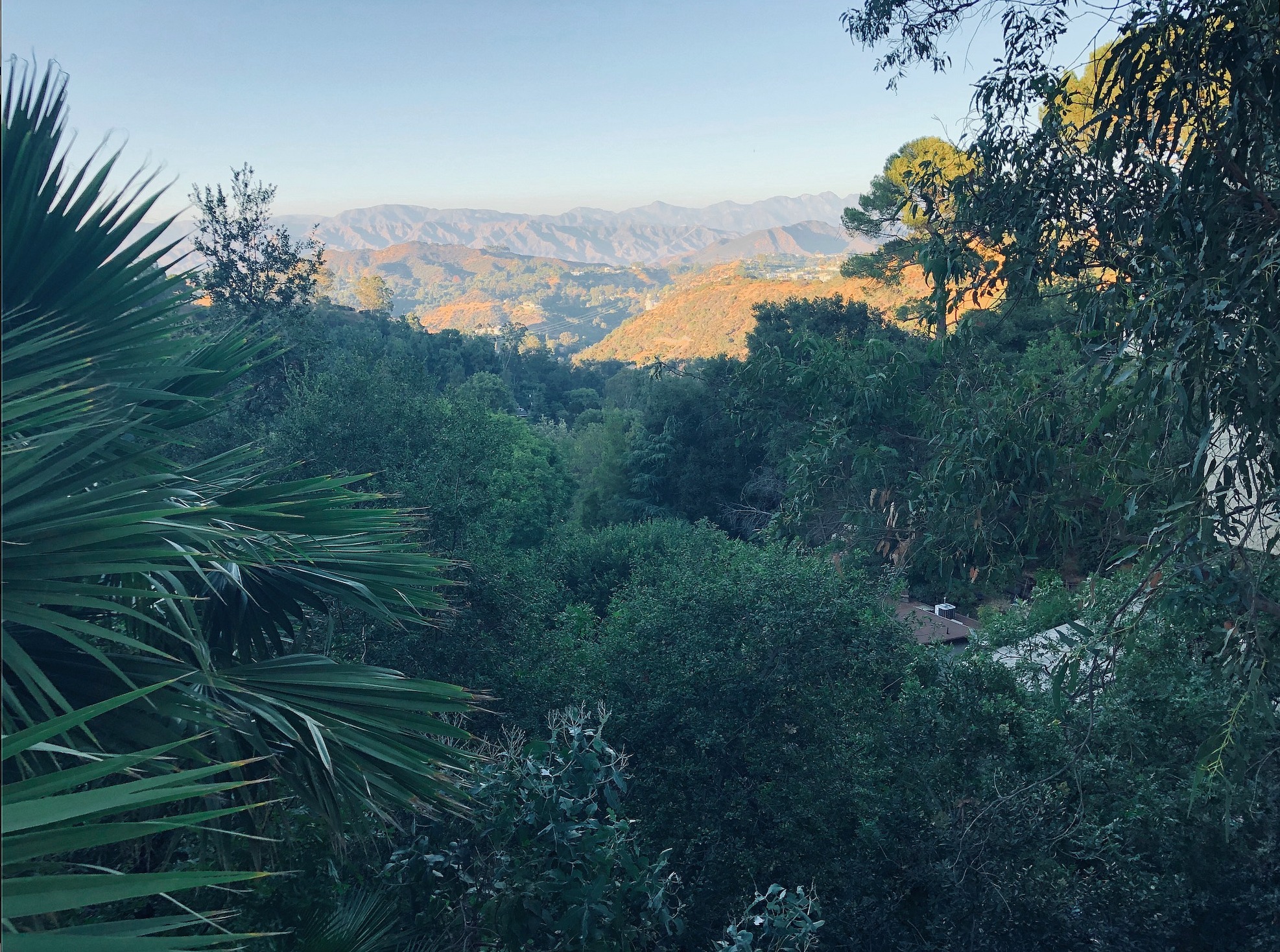
Late yesterday afternoon we did a modest 75-minute hike. Huffing and puffing up Kirkwood (35 degree uphill incline), and then a hard right on Appian Way. Pretty much the highest point in the hills. Clean air, blue sky, nice feeling.



I re-watched Robert Zemeckis and Tom Hanks‘ Cast Away last night. I’d seen it only once before, when it opened 20 years ago. All this time I’ve been nurturing favorable recollections, or at least a pleasant notion that it was a better-than-decent film. I have to say that I now regard Cast Away as handsome, ambitious and certainly well-produced, but generally unexceptional or just, you know, “agreeably meh.”
It would have been so much better if Hanks hadn’t shouted “Wilson!” about 385 times. I literally sat up on the couch last night and said to the TV, “Good God, will you shut the hell up?” I’m not talking about Hanks’ character loving and needing a beat-up, blood-spattered volleyball as a companion — that part’s fine — but hearing that name shouted over and over and over is infuriating.
And that moment when Hanks’ married ex-girlfriend (Helen Hunt) faints dead away when she’s told that he’s been rescued…terrible.
The final scene has a nice aura but it doesn’t really “say” anything except “okay, you’re a survivor…alive and relatively young so where do you want to go?” Almost every alert person on the planet earth faces the same question each and every day…no? But when you think about it the ending doesn’t really connect with Hanks’ character or what he’s gone through…it feels like a moderately profound moment but there’s no connective tissue that relates to the substance of the film. It’s just nicely shot and scored and visually pleasing with the vast West Texas flatness. It would’ve been so much better without that pretty girl pulling over in her pickup truck and asking if he needs help, etc. Pretty girls don’t do that…sorry.
That third-act scene in which Hanks and Hunt acknowledge their still-intense love but nonetheless agree to part ways during an evening rainstorm? Probably the best moment in the whole film.
…in weekly unemployment supplements until the end of the year, according to Trump’s just-announced executive order. Does he have the real-deal authority to ensure this, or is this just bullshit grandstanding?
Last night Orange Plague and his stooge, Postmaster General Louis DeJoy, began to blatantly finagle in order to interfere with postal voting in the 11.3.20 election. They’re trying to make it as difficult as possible for Average Schmoes to vote for Biden, and for the post-election count to be as slow and challenge-able as possible. This is a bully dictator move, and it’s 100% real.
DeJoy unveiled “a sweeping overhaul of the nation’s mail service, displacing the two top executives overseeing day-to-day operations,” according to an 8.7 Washington Post story by Jacob Bogage. “The shake-up came as congressional Democrats called for an investigation of DeJoy and the cost-cutting measures that have slowed mail delivery and ensnared ballots in recent primary elections.
“The #USPostalService helped build this country by uniting Americans in the biggest cities, smallest towns, and most remote rural areas,” said PFAWF President @BenJealous. "Especially now, across America, we need our Post Office." #DefendOurPostOffice during #coronavirus. pic.twitter.com/85XOkedt9R
— PFAW (@peoplefor) August 3, 2020
“Twenty-three postal executives were reassigned or displaced, the new organizational chart shows. Analysts say the structure centralizes power around DeJoy, a former logistics executive and major ally of President Trump, and de-emphasizes decades of institutional postal knowledge. All told, 33 staffers included in the old postal hierarchy either kept their jobs or were reassigned in the restructuring, with five more staffers joining the leadership from other roles.”
From 8.8. N.Y. Times report, “The Voting Will End Nov. 3 — The Legal Battle Probably Won’t“: “A greater reliance on mail-in voting [due to COVID] could prolong the counting in a way that turns Election Day into Election Week or Election Month. And the atmosphere has been inflamed by a president who is already using words like ‘coup,’ “fraud” and “corrupt” to delegitimize the vote even before it happens.”
I for one completely sympathize with Maureen Dowd‘s mistaken conveyance in her latest column, “No Wrist Corsages, Please.”
She wrote about Joe Biden‘s stated intention to choose a woman (and probably a non-Anglo) as his vice-presidential running mate, and the fact that 36 years have passed since a Democratic presidential candidate selected a woman in this capacity (i.e., Walter Mondale + Geraldine Ferraro). But in the initial version Dowd wrote that it had been 36 years since a man and a woman had run together on a Democratic Party ticket.
Dowd forgot, in short, that Hillary Clinton and Tim Kaine ran against Trump-Pence in 2016.
But who can blame her? Has there ever been a blander and more forgettable vp wannabe than Kaine? Not to mention the fact that Clinton all but ensured her defeat by alienating the Bernie Bros and Jill Stein fringies when she chose Kaine instead of a vigorous progressive (like Elizabeth Warren) as her running mate. She was so fucking blind to what the electorate was screaming for in ’16 (“shake it up…jettison the usual usual”) that she chose a go-along, do-no-harm moderate liberal like Kaine. And in so doing she gave us Donald Trump.
In other words Dowd’s mind rejected the memory of the Clinton-Kaine catastrophe because it was too painful. I get it. I understand the syndrome.

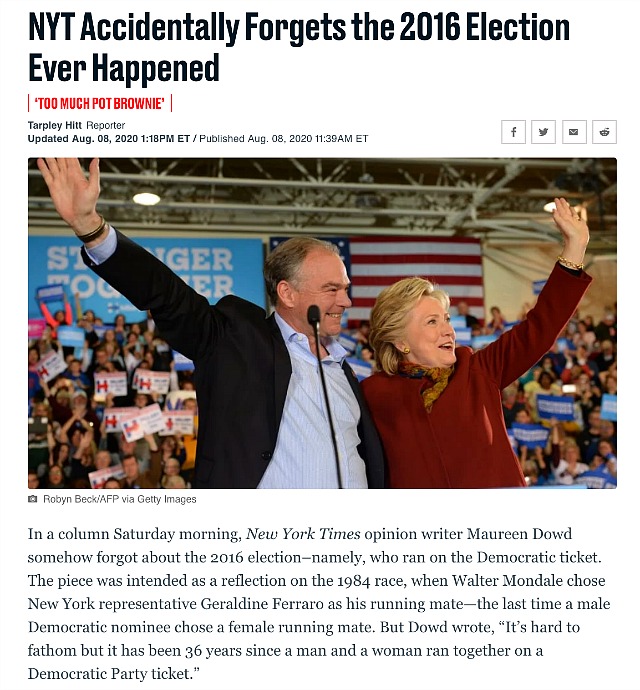
I finally forced myself to watch David Ayer‘s The Tax Collector…yeesh. Not by any stretch a career highlight for Ayer, whose best effort as a director-writer so far has been Fury, which I didn’t even care for all that much. Mostly an ultra-violent wallow, like everyone has said. What a hellish realm. Hit me over the head with a shovel.
But I didn’t mind Shia LaBeouf‘s “racist” performance as Creeper, a psychopathic collection guy working for Jimmy Smits‘ crime lord, “Wizard.” At the very least he’s delivering with a certain impudent energy mixed with a willingness to die on the spot.
We all understand the rule about white guys not being allowed to portray POCs and cisgenders not being allowed to play trans folk, but there’s a part of me that admires the “fuck you” attitude that Ayer and LaBeouf obviously embraced in creating this particular “Creeper.”
I think any actor should be allowed to portray any character of whatever ethnic stripe. It all boils down to “can you sell it…can you be it…do you have the bravery and conviction?”
In other words, I was kidding when I wrote the headline for this post. I was pretending to be a wokester asshole.
Five or six days ago Indiewire‘s Eric Kohn accused LaBeouf of giving “a cartoonish and culturally insensitive performance” that amounted to “a two-bit Latino burlesque.”
Last month Ayer said on Twitter that LaBeouf wasn’t delivering a “brownface” parody but playing “a white character who is influenced by latinx culture. Which is a really important answer. Shia is playing a whiteboy who grew up in the hood. This is a Jewish dude playing a white character. Also the only white dude in the movie”.
But again, the idea of LaBeouf tattooing his entire chest and stomach area for this role….what an asinine thing to do! What a way of spitting upon your God-given biological temple.

I sauntered over to Urth Caffe this morning for a couple of large cappuccinos. I gave my order to a short Latina named “H. Celso.” She asked for my name and I said “Jeff.” I didn’t slur or mutter it — I said my name as plainly as a Kansas wheat farmer saying the word “fence.” Naturally she misheard and wrote “Bret” on the order ticket. Which of course was my fault because WHITE GUY.
Five or six minutes later a young Latino waiter was roaming around with two large cappuccinos and calling out “Brad? Two cappuccinos…Brad?” I went up to him and said, “Uhm, I may have ordered these but my name is Jeff, not Brad.” He took my word for it.
H. Celso’s order ticket told me about the “Bret” misunderstanding. My hearing “Brad” rather than “Bret” when the waiter called it was, no kidding around this time, definitely my fault. His pronunciation of “Bret” became “Brad” to my ears, what with the clatter of the cafe and the waiter’s lack of interest in emphasizing a hard “t” sound after the first three letters.
The last time I even heard “Bret” was 26 years ago, during that Pulp Fiction scene when John Travolta and Samuel L. Jackson pay a visit to the apartment of Frank Whalley‘s “Bret” (technically spelled “Brett” on the Wikipedia page) and his young pallies. Correct me if I’m wrong but the first Bret in the history of U.S. entertainment industry was James Garner‘s gambler character on the original Maverick series, which ran on ABC between ’57 and ’62.

Tatiana had never seen Contagion so we watched it last night — my fourth or fifth time, but God, such a brilliant film, and so far ahead of the curve it wasn’t funny. It did fairly well financially, but it failed to catch on as a Best Picture contender. It should have. It didn’t predict the future — it knew it cold. This message appears at the very end of the credits:

“Contagion Reboot,” posted on 11.19.11: Last night Warner Bros. publicity made a spirited, gung-ho attempt to re-launch Steven Soderbergh‘s Contagion among award-season cognoscenti and to put it into “the conversation,” so to speak. They invited journos like myself to a pleasant, talent-populated soiree (Soderbergh, Benicio del Toro, Garry Shandling, Contagion producers Michael Shamberg and Stacey Sher, screenwriter Scott Burns) inside the Clarity lobby-rotunda, and followed this with a screening of the film.
The pitch was basically “this is an undeniably gripping, highly intelligent, superbly-made socio-political-scientific thriller“” — no argument from me — “so why isn’t it being mentioned a bit more in terms of awards chatter, best-of-the-year lists and so on?”
The best response I can think of is that Contagion is going on a best-of-2011 list…mine, I mean. My second response is that with Contagion having made about $75 million domestic, what’s the beef? And my third response is that it’s about a subject — social devastation caused by a pathogen — that unsettles people on a very deep level, perhaps more than they know going in, and so I’m guessing they’d rather just leave it at that and not revisit the Contagion reality any more, thanks.
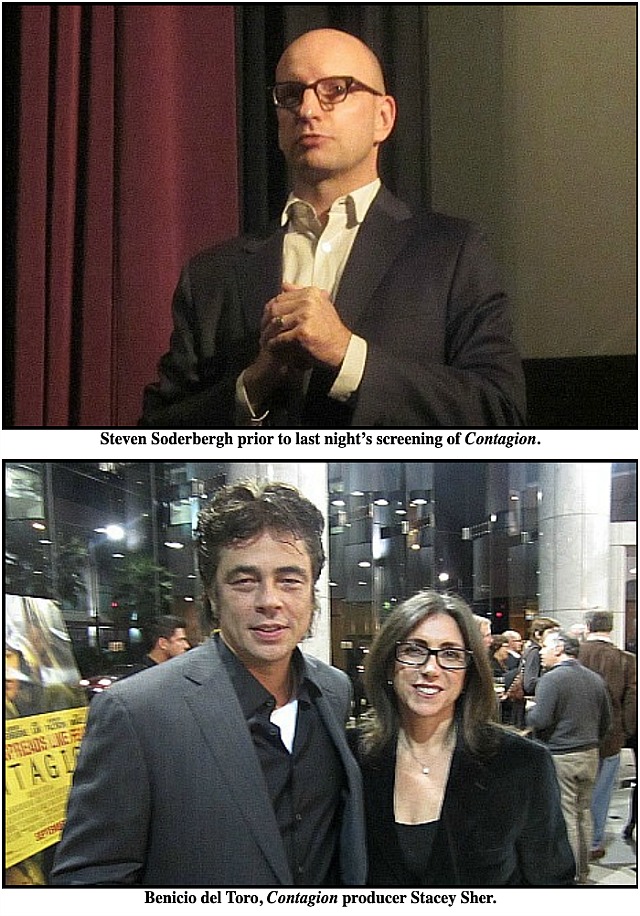
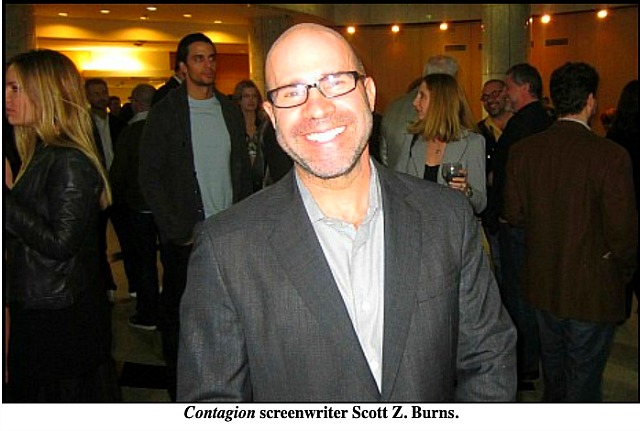
I mean, I was scratching my face all through last night’s screening, and half-wondering if there was something wrong with me because of this, absurd as that sounds. I don’t mind seeing Gwynneth Paltrow die horribly, but I don’t want to go the same way…please.
On top of which Warner Bros. decided to open Contagion in early September. This conveyed to all that (a) they were going for the money (and a $75 million haul is nothing to sneeze at) and (b) the studio felt it was good enough to release in a quality-friendly portion of the calendar but that it wasn’t necessarily an awards contender or they would have opened it in late October or November or December.
There are three other factors: (1) Contagion is an intellectual-technical chiller (as opposed to an emotional drama of some kind) and is therefore regarded as a kind of “genre” film, and that kind of distinction rarely leads to awards chatter; (2) To some extent Contagion is, let’s face it, emotionally dry or reserved, like many of Soderbergh’s films (a quality I’ve always rather enjoyed and in fact praised); and (3) It doesn’t contain one of those thematic echoes or undercurrents that Oscar-season films tend to have, nor does it deliver some basic recognizable truth.
Yes, it says that “it’s entirely possible that millions of us might suddenly die some day due to a runaway virus” but that’s not a basic recognizable truth. If it happens, that would be an anecdotal fact.
Here’s my early September review. I love Contagion. It’s going on my best-of-the-year list, no question. And I especially loved the performances by Jennifer Ehle (her bedside scene with her ailing dad is one of the few genuinely affecting emotional moments), Kate Winslet, Jude Law, Matt Damon, Elliott Gould and Laurence Fisburne. And I can’t wait for the Bluray, and I wish it would be longer when it comes out in that format.
“You can’t eat the Venetian blinds…I just had ’em installed on Wednesday.”
Deadline‘s Justin Kroll, filed at 1:40 pm: “After earning some of the best reviews of his acting career for The Way Back, Ben Affleck is ready to make his return behind the camera, and he looks to have zeroed in on his next directing job. We are hearing that Affleck has signed on to direct The Big Goodbye for Paramount, an adaptation of the Sam Wasson book “The Big Goodbye: Chinatown and the Last Years of Hollywood.”
“Affleck also would write the script. SNL’s Lorne Michaels pursued the rights to the book and brought it to the studio and will produce along with Affleck.
“The novel tells the behind-the-scenes story of the 1974 film noir classic starring Jack Nicholson and Faye Dunaway. From Roman Polanski’s directing and Robert Towne’s Oscar-winning script to the twist ending that shook filmgoers to their core, Chinatown joined the long list of films to make their mark during the 1970s. Looming over the story of the classic movie is the imminent eclipse of the ’70s filmmaker-friendly studios as they gave way to the corporate Hollywood we know today.”
Idle HE thought #1: Neat idea and a potentially a great emotional movie, but who plays Jack Nicholson? I’ll tell you who plays Nicholson. No one, that’s who. Idle HE thought #2: I thought Roman Polanski was persona non grata these days, even retroactively. It will be a tough casting call for Affleck as whomever he hires to play Polanski may, I’m supposing, have a tough time politically with progressive industry women. At the very least the Polanski actor will get the slant-eye all over town.
I’m sorry but I didn’t watch this two-week-old video (7.27.20) until this afternoon. Recorded 40 damn years ago…Jesus.
If a magically younger Mel Brooks were to somehow make Young Frankenstein for the first time today, he would become a #MeToo pariah — instant Roman Polanski hate vibes. And no distributor would touch the film with a 10-foot pole…”Blucher!”
The forthcoming Hulu series Woke is about a mild-mannered African American cartoonist (“keep it light”) who becomes ultra-attuned to systemic racism after he gets beaten up by cops. Everywhere he looks and everything he hears tells him that the world is not what it seems and that “the fix is in” against people of color. Or something close to that.
This is a righteous concept, but it’s a bit out-of-time to call the series Woke because black-dude woke was a thing about…what, eight or ten years ago? We all know that since Trump’s election in late ’16 “woke” stopped alluding to hip-black-guy consciousness and became a “white progressives committed to destroying the careers of non-wokesters in order to stop the twin scourges of racism and sexism” thang…Khmer Rouge, cancel culture, Left Twitter, resurrecting the legacy of Maximilien Robespierre, the New McCarthyism in academia, etc.
So I’m sorry but Woke is out of step with the times. I’m not saying that hip African Americans embracing a “woke” perspective isn’t valid. Obviously it is. I’m saying that the term “woke” began to be co-opted by the white lunatic progressive left four years ago.
Woke arrives on Hulu on September 9. Lamorne Morris plays Keef, the lead character. Sasheer Zamata, Blake Anderson and T. Murph costar.